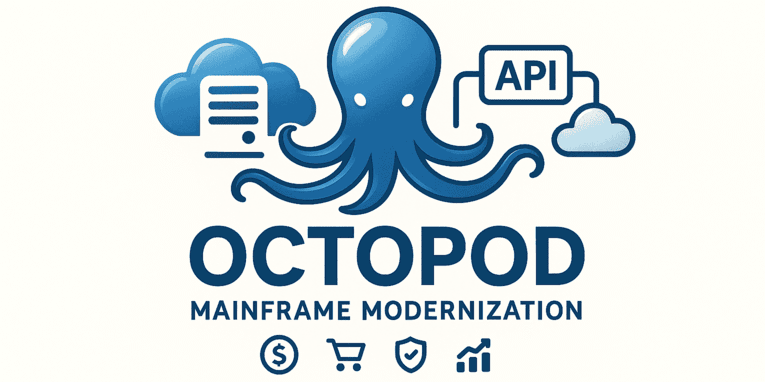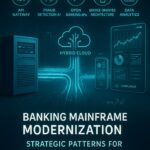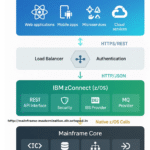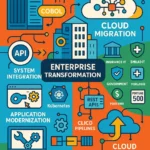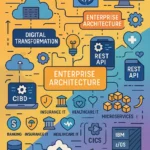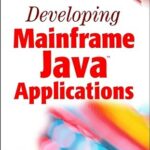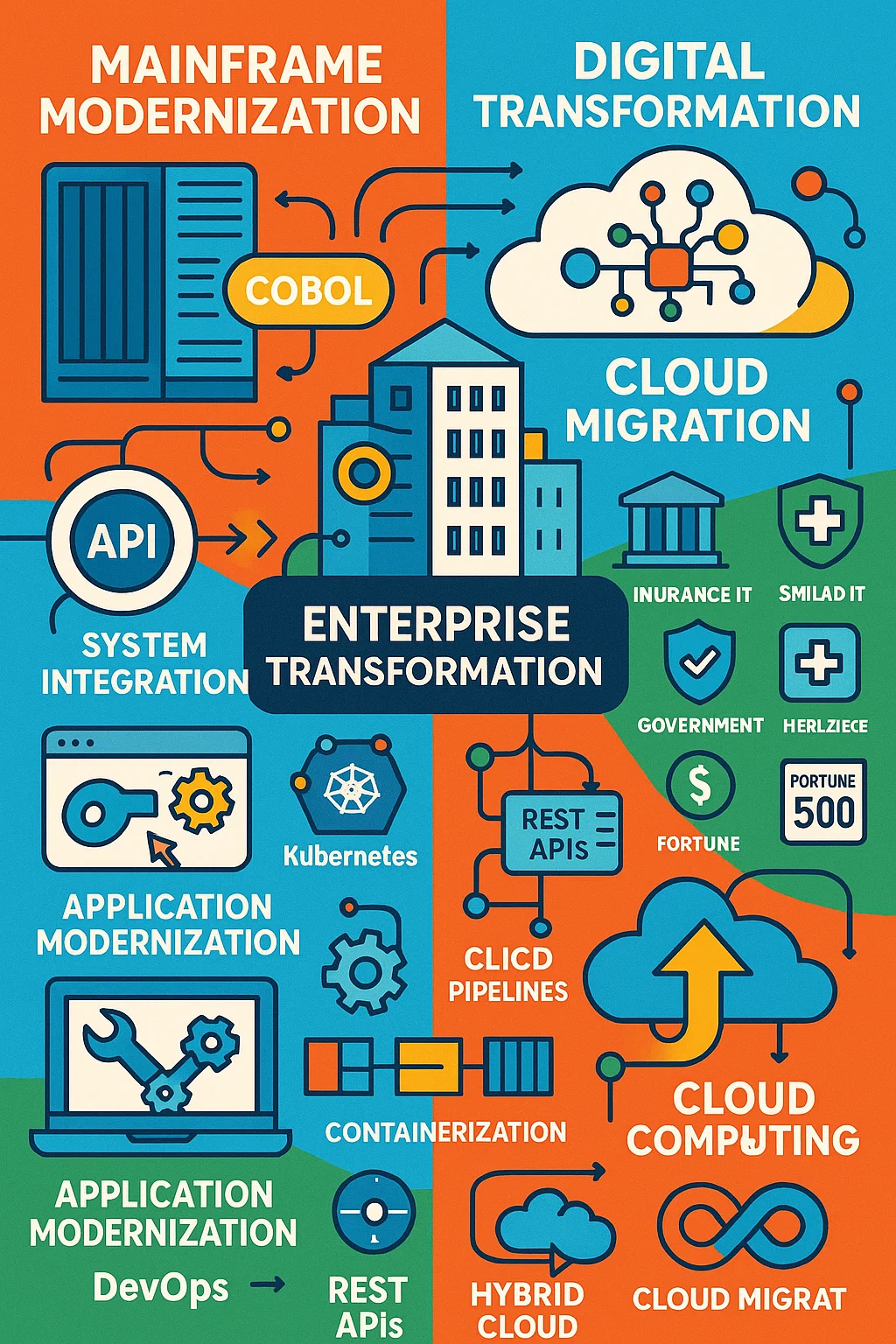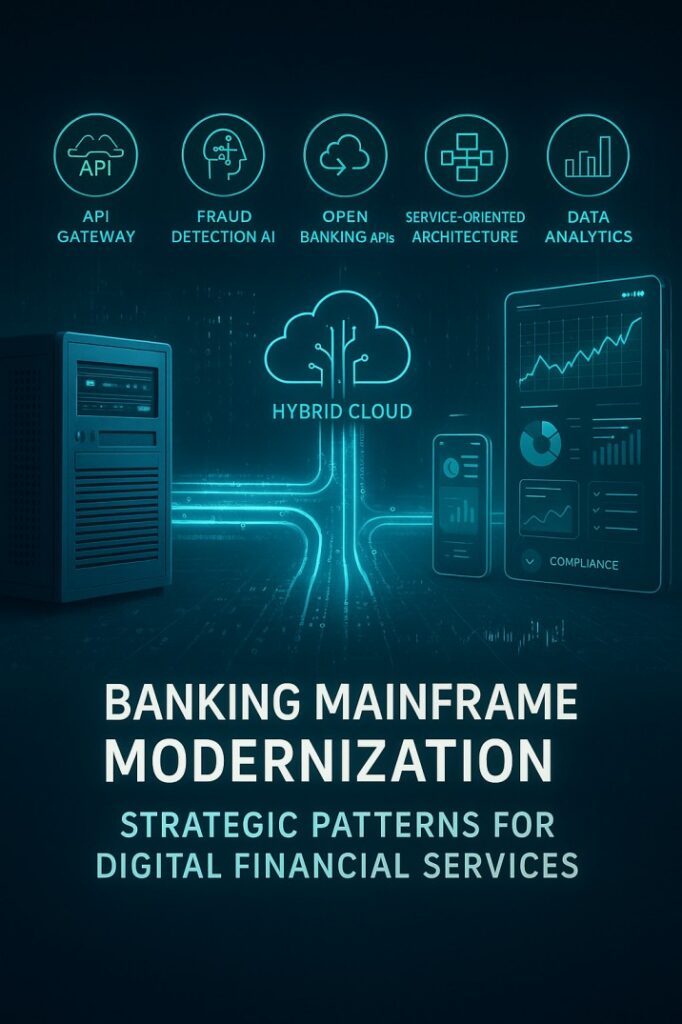- Blog Post #1: Introduction – Why Mainframe Modernization Matters in 2025
- The Hidden Backbone of Digital Transformation
- What Makes Mainframe Modernization Different?
- Who Should Follow This Learning Series?
- What You’ll Achieve in 12 Months
- Your Learning Journey Roadmap
- Blog Post #2: Foundation Phase (Months 1-2) – Building Your Mainframe Modernization Base
- Strengthening Your Core Mainframe Knowledge
- Key Learning Objectives for Months 1-2:
- Practical Exercises for Months 1-2:
- Resources and Tools:
- Success Metrics:
- Blog Post #3: API Enablement Phase (Months 3-4) – Connecting Legacy with Modern
- The API Revolution in Mainframe Modernization
- Key Learning Objectives for Months 3-4:
- Hands-On Projects for Months 3-4:
- Industry Best Practices:
- Tools and Platforms:
- Success Metrics:
- Blog Post #4: Automation Phase (Months 5-6) – DevOps and AI-Powered Development
- Revolutionizing Mainframe Development with Automation
- Key Learning Objectives for Months 5-6:
- Advanced Projects for Months 5-6:
- AI-Powered Development Workflows:
- DevOps Tools and Technologies:
- Success Metrics:
- Blog Post #5: Security & Messaging Phase (Months 7-8) – Enterprise-Grade Integration
- Fortifying Your Mainframe Modernization with Security and Messaging
- Key Learning Objectives for Months 7-8:
- Enterprise Integration Patterns:
- Security Implementation Projects:
- Security Best Practices:
- Tools and Technologies:
- Success Metrics:
- Blog Post #6: Observability Phase (Months 9-10) – Monitoring and AI-Enhanced Development
- Gaining Visibility into Your Hybrid Mainframe Environment
- Key Learning Objectives for Months 9-10:
- Observability Architecture:
- Advanced Monitoring Projects:
- AI-Enhanced Development Workflows:
- Monitoring Tools and Platforms:
- Success Metrics:
- Blog Post #7: Project Implementation Phase (Months 11-12) – Real-World Application
- Bringing It All Together: Your Capstone Modernization Project
- Key Learning Objectives for Months 11-12:
- Capstone Project Ideas:
- Project 1: Banking Transaction Modernization
- Project 2: Supply Chain Integration Platform
- Project 3: Customer Service Modernization
- Project Implementation Methodology:
- Professional Development Activities:
- Industry Networking Opportunities:
- Portfolio Development Guidelines:
- Success Metrics for Final Phase:
- Blog Post #8: Conclusion – Your Modernization Career Path Forward
- Celebrating Your 12-Month Achievement
- Skills You’ve Mastered:
- Career Opportunities Ahead:
- Continuing Your Growth:
- Building Your Professional Brand:
- The Future of Mainframe Modernization:
- Complete Blog Series Summary
Blog Post #1: Introduction – Why Mainframe Modernization Matters in 2025
The Hidden Backbone of Digital Transformation
While the tech world buzzes about AI, cloud computing, and microservices, 80% of enterprise transactions still run on mainframes. These powerful systems, processing over 30 billion business transactions daily, aren’t disappearing—they’re evolving. For IT professionals, understanding mainframe modernization isn’t just a career boost; it’s becoming essential.
What Makes Mainframe Modernization Different?
Mainframe modernization isn’t about replacing legacy systems; it’s about extending their capabilities with modern technologies. This involves:
- API enablement through tools like IBM z/OS Connect
- Cloud integration using services like AWS Bluage
- AI-powered development with IBM watsonx
- Modern messaging via IBM MQ
- Microservices architecture with Spring Boot
Who Should Follow This Learning Series?
This 12-month blog series is designed for IT professionals with some foundational knowledge in:
- Basic mainframe concepts (COBOL, PL/I, z/OS)
- Cloud platforms (AWS, Azure, GCP)
- API development and microservices
- Java/Spring Boot development
- Enterprise messaging systems
What You’ll Achieve in 12 Months
By following this series, you’ll master:
- Modern mainframe integration patterns
- AI-assisted modernization workflows
- Hybrid cloud architectures
- Enterprise-grade API development
- Real-world project implementation
Your Learning Journey Roadmap
This series is divided into 6 comprehensive phases, each spanning 2 months:
- Foundation & Integration Basics (Months 1-2)
- API Enablement & Cloud Integration (Months 3-4)
- Automation & DevOps (Months 5-6)
- Security & Advanced Messaging (Months 7-8)
- Observability & AI Development (Months 9-10)
- Real-World Projects & Industry Exposure (Months 11-12)
Blog Post #2: Foundation Phase (Months 1-2) – Building Your Mainframe Modernization Base
Strengthening Your Core Mainframe Knowledge
The modernization journey begins with solidifying your understanding of z/OS architecture, COBOL/PL/I programming, and CICS transaction processing. Even if you have basic knowledge, focusing on modernization-ready coding practices is crucial.
Key Learning Objectives for Months 1-2:
Week 1-2: z/OS Architecture Deep Dive
- Understanding LPAR (Logical Partition) concepts and workload management
- Exploring Job Control Language (JCL) and batch processing
- Learning TSO/ISPF navigation and dataset management
Week 3-4: COBOL/PL/I Modernization Practices
- Writing modular, reusable COBOL programs
- Understanding copybook design for API enablement
- Learning error handling patterns for modern integration
Week 5-6: IBM MQ Fundamentals
- Understanding message queuing concepts and patterns
- Setting up MQ channels and queue managers
- Implementing reliable messaging between systems
Week 7-8: Spring Boot Introduction
- Building REST APIs with Spring Boot
- Understanding dependency injection and configuration
- Creating microservices architecture basics
Practical Exercises for Months 1-2:
- Create a simple COBOL program that reads data and formats it for API consumption
- Set up IBM MQ and send messages between applications
- Build a Spring Boot REST API that could theoretically integrate with mainframe data
- Document your learning with code samples and architectural diagrams
Resources and Tools:
- IBM Developer Portal for z/OS tutorials
- Spring Boot Official Documentation
- IBM MQ Knowledge Center
- GitHub repositories with sample COBOL and Spring Boot code
Success Metrics:
By the end of Month 2, you should be able to:
- Navigate z/OS efficiently and understand system architecture
- Write clean, modular COBOL code suitable for modernization
- Set up and configure IBM MQ messaging
- Create basic Spring Boot applications with REST endpoints
Blog Post #3: API Enablement Phase (Months 3-4) – Connecting Legacy with Modern
The API Revolution in Mainframe Modernization
APIs are the bridges between mainframe powerhouses and modern applications. This phase focuses on IBM z/OS Connect and AWS Bluage to unlock your mainframe’s potential in the cloud era.
Key Learning Objectives for Months 3-4:
Week 9-10: IBM z/OS Connect Mastery
- Installing and configuring z/OS Connect Enterprise Edition
- Creating RESTful APIs from COBOL programs and CICS transactions
- Understanding API security and authentication patterns
Week 11-12: Spring Boot Advanced Integration
- Building Spring Boot microservices that consume mainframe APIs
- Implementing circuit breaker patterns for resilient integration
- Using Spring Cloud Gateway for API management
Week 13-14: AWS Bluage Exploration
- Understanding AWS Bluage services and capabilities
- Setting up cloud-native processing for mainframe workloads
- Implementing hybrid architectures with AWS and mainframe
Week 15-16: End-to-End Integration
- Creating complete integration workflows
- Testing API performance and reliability
- Documenting APIs with OpenAPI/Swagger
Hands-On Projects for Months 3-4:
- Expose a COBOL CICS transaction as a REST API using z/OS Connect
- Build a Spring Boot service that orchestrates multiple mainframe APIs
- Create an AWS Bluage workflow that processes mainframe data in the cloud
- Develop comprehensive API documentation with usage examples
Industry Best Practices:
- API versioning strategies for long-term maintenance
- Error handling and status codes for robust integration
- Rate limiting and throttling for performance management
- Monitoring and logging for operational excellence
Tools and Platforms:
- IBM z/OS Connect Enterprise Edition
- Spring Boot 3.x with Spring Cloud
- AWS Bluage Studio
- Postman or Insomnia for API testing
- Swagger/OpenAPI for documentation
Success Metrics:
By Month 4, you should have:
- Successfully exposed mainframe services as modern APIs
- Built resilient Spring Boot applications consuming these APIs
- Implemented basic AWS Bluage processing workflows
- Created professional API documentation
Blog Post #4: Automation Phase (Months 5-6) – DevOps and AI-Powered Development
Revolutionizing Mainframe Development with Automation
Modern mainframe modernization demands automated workflows. This phase introduces IBM watsonx Code Assistant and DevOps practices tailored for hybrid environments.
Key Learning Objectives for Months 5-6:
Week 17-18: DevOps for Mainframe Environments
- Setting up CI/CD pipelines for mainframe and cloud deployments
- Understanding version control for COBOL and JCL
- Implementing automated testing for mainframe applications
Week 19-20: IBM watsonx Code Assistant Deep Dive
- Using AI-powered code generation for COBOL modernization
- Implementing automated refactoring of legacy code
- Leveraging intelligent code suggestions for API development
Week 21-22: Containerization and Orchestration
- Dockerizing Spring Boot applications for cloud deployment
- Understanding Kubernetes basics for microservices orchestration
- Implementing container security best practices
Week 23-24: Infrastructure as Code
- Using Terraform or CloudFormation for AWS resource management
- Implementing configuration management for hybrid environments
- Setting up monitoring and alerting automation
Advanced Projects for Months 5-6:
- Build a complete CI/CD pipeline that deploys both mainframe and cloud components
- Use IBM watsonx to modernize a legacy COBOL program automatically
- Containerize and deploy a Spring Boot application to Kubernetes
- Implement infrastructure as code for your AWS Bluage environment
AI-Powered Development Workflows:
- Code Generation: Using watsonx to create API wrappers for COBOL programs
- Automated Testing: Generating test cases for mainframe applications
- Documentation: AI-assisted creation of technical documentation
- Code Review: Automated quality checks and suggestions
DevOps Tools and Technologies:
- Jenkins or GitLab CI for pipeline automation
- IBM watsonx Code Assistant for AI-powered development
- Docker and Kubernetes for containerization
- Terraform for infrastructure automation
- SonarQube for code quality management
Success Metrics:
By Month 6, you should have:
- Functional CI/CD pipelines for hybrid deployments
- Experience using IBM watsonx for code modernization
- Containerized applications running in Kubernetes
- Automated infrastructure provisioning capabilities
Blog Post #5: Security & Messaging Phase (Months 7-8) – Enterprise-Grade Integration
Fortifying Your Mainframe Modernization with Security and Messaging
Enterprise systems demand robust security and reliable messaging. This phase focuses on advanced IBM MQ patterns, enterprise security, and API protection.
Key Learning Objectives for Months 7-8:
Week 25-26: Advanced IBM MQ Messaging
- Implementing message clustering and high availability
- Understanding publish/subscribe patterns for event-driven architecture
- Setting up MQ monitoring and performance tuning
Week 27-28: Enterprise API Security
- Implementing OAuth2 and JWT authentication
- Understanding RACF integration with modern security protocols
- Setting up TLS encryption for API communications
Week 29-30: Event-Driven Architecture
- Building event streaming with IBM MQ and Apache Kafka
- Implementing saga patterns for distributed transactions
- Understanding CQRS (Command Query Responsibility Segregation)
Week 31-32: Security Hardening
- Implementing API gateway security policies
- Understanding zero-trust architecture principles
- Setting up comprehensive audit logging
Enterprise Integration Patterns:
- Message Router: Directing messages based on content
- Content-Based Router: Dynamic routing using message properties
- Scatter-Gather: Distributing requests and aggregating responses
- Circuit Breaker: Preventing cascading failures in distributed systems
Security Implementation Projects:
- Secure API Gateway: Implement comprehensive authentication and authorization
- Event-Driven Order Processing: Build a complete event streaming solution
- Audit Trail System: Create comprehensive logging for compliance
- High-Availability Messaging: Set up resilient MQ clustering
Security Best Practices:
- API rate limiting and throttling
- Input validation and sanitization
- Encryption at rest and in transit
- Regular security audits and penetration testing
- Compliance with regulations (SOX, PCI-DSS, GDPR)
Tools and Technologies:
- IBM MQ Advanced for enterprise messaging
- Spring Security for application-level security
- HashiCorp Vault for secrets management
- Apache Kafka for event streaming
- OWASP ZAP for security testing
Success Metrics:
By Month 8, you should have:
- Robust messaging architecture with high availability
- Comprehensive security implementation across all components
- Event-driven processing capabilities
- Enterprise-grade audit and compliance features
Blog Post #6: Observability Phase (Months 9-10) – Monitoring and AI-Enhanced Development
Gaining Visibility into Your Hybrid Mainframe Environment
Modern systems require comprehensive observability. This phase focuses on monitoring, logging, and AI-enhanced development using advanced tools and techniques.
Key Learning Objectives for Months 9-10:
Week 33-34: Comprehensive Observability
- Implementing OpenTelemetry for distributed tracing
- Setting up ELK Stack (Elasticsearch, Logstash, Kibana) for log management
- Understanding metrics, logs, and traces correlation
Week 35-36: Advanced IBM watsonx Usage
- Code optimization using AI recommendations
- Automated bug detection and resolution suggestions
- Performance tuning with AI-powered insights
Week 37-38: Performance Monitoring
- Setting up application performance monitoring (APM)
- Implementing custom metrics for business KPIs
- Understanding SLA/SLO/SLI frameworks
Week 39-40: Incident Response and Automation
- Building automated incident response workflows
- Implementing alert correlation and noise reduction
- Setting up chaos engineering practices
Observability Architecture:
- Data Collection: Gathering metrics from all system components
- Data Processing: Aggregating and correlating information
- Visualization: Creating meaningful dashboards and reports
- Alerting: Proactive notification of issues
- Analysis: Using AI to identify patterns and predict problems
Advanced Monitoring Projects:
- Distributed Tracing: Track requests across mainframe and cloud
- Business Metrics Dashboard: Monitor KPIs in real-time
- Predictive Analytics: Use AI to predict system failures
- Automated Remediation: Build self-healing systems
AI-Enhanced Development Workflows:
- Code Quality: Automated code review and suggestions
- Performance Optimization: AI-driven performance improvements
- Security Scanning: Intelligent vulnerability detection
- Documentation Generation: Automated technical documentation
Monitoring Tools and Platforms:
- OpenTelemetry for observability standards
- ELK Stack or Splunk for log management
- Prometheus and Grafana for metrics visualization
- IBM watsonx for AI-enhanced development
- PagerDuty or Opsgenie for incident management
Success Metrics:
By Month 10, you should have:
- Comprehensive observability across all system components
- AI-enhanced development workflows
- Proactive monitoring and alerting
- Automated incident response capabilities
Blog Post #7: Project Implementation Phase (Months 11-12) – Real-World Application
Bringing It All Together: Your Capstone Modernization Project
The final phase focuses on real-world implementation and industry engagement. You’ll build comprehensive projects and establish professional visibility.
Key Learning Objectives for Months 11-12:
Week 41-44: Capstone Project Development
- Planning and designing end-to-end modernization solution
- Implementing all learned technologies in integrated project
- Following enterprise development practices
Week 45-48: Industry Engagement and Portfolio Building
- Participating in hackathons and challenges
- Building professional portfolio with project showcases
- Networking with industry professionals
Capstone Project Ideas:
Project 1: Banking Transaction Modernization
Objective: Modernize a core banking transaction system
Technologies: COBOL, z/OS Connect, Spring Boot, IBM MQ, AWS Bluage, IBM watsonx
Features:
- API-enabled account transactions
- Real-time fraud detection using AI
- Cloud-based analytics and reporting
- Comprehensive security and audit trails
Project 2: Supply Chain Integration Platform
Objective: Create hybrid supply chain management system
Technologies: PL/I, Spring Boot, IBM MQ, Kubernetes, OpenTelemetry
Features:
- Legacy inventory integration via APIs
- Event-driven order processing
- Real-time tracking and monitoring
- Predictive analytics for demand forecasting
Project 3: Customer Service Modernization
Objective: Transform customer service operations
Technologies: CICS, z/OS Connect, Spring Boot, AI/ML services
Features:
- API-enabled customer data access
- Chatbot integration with mainframe systems
- Real-time sentiment analysis
- Automated case routing and escalation
Project Implementation Methodology:
Phase 1: Planning and Design (Week 41)
- Requirements gathering and analysis
- Architecture design and technology selection
- Project timeline and milestone definition
Phase 2: Development (Weeks 42-43)
- Core functionality implementation
- Integration between components
- Security and performance optimization
Phase 3: Testing and Deployment (Week 44)
- Comprehensive testing strategies
- Performance and security testing
- Deployment and monitoring setup
Phase 4: Documentation and Presentation (Weeks 45-46)
- Technical documentation creation
- User guides and API documentation
- Project presentation preparation
Phase 5: Industry Engagement (Weeks 47-48)
- Portfolio website development
- LinkedIn and GitHub profile optimization
- Community participation and networking
Professional Development Activities:
- Hackathon Participation: Join mainframe modernization challenges
- Open Source Contribution: Contribute to relevant projects
- Conference Presentations: Share your learning journey
- Mentorship: Help others starting their modernization journey
- Certification Achievement: Complete relevant certifications
Industry Networking Opportunities:
- IBM Developer Community events and forums
- AWS Bluage User Groups and meetups
- Spring Boot Community conferences
- Mainframe Modernization professional associations
- LinkedIn Professional Groups focused on enterprise modernization
Portfolio Development Guidelines:
Technical Portfolio Components:
- Project Repositories: Well-documented GitHub projects
- Technical Blog Posts: Share your learning insights
- Video Demonstrations: Showcase project functionality
- Architecture Diagrams: Visual representation of solutions
Professional Presentation:
- LinkedIn Profile: Highlight modernization skills
- Personal Website: Professional portfolio showcase
- Resume Enhancement: Emphasize practical experience
- Reference Projects: Quantifiable business impact
Success Metrics for Final Phase:
By Month 12, you should have:
- Completed comprehensive modernization project
- Established professional visibility in the community
- Built network of industry connections
- Achieved relevant certifications
- Secured opportunities for career advancement
Blog Post #8: Conclusion – Your Modernization Career Path Forward
Celebrating Your 12-Month Achievement
Congratulations! You’ve completed a comprehensive journey through mainframe modernization, mastering cutting-edge technologies like IBM watsonx, AWS Bluage, Spring Boot, IBM MQ, and z/OS Connect. You’re now equipped with skills that bridge traditional enterprise computing with modern cloud-native architectures.
Skills You’ve Mastered:
Technical Expertise:
- Advanced mainframe programming and architecture
- Modern API development and integration
- Cloud-native application development
- AI-powered development workflows
- Enterprise security and messaging
- Comprehensive system observability
Professional Capabilities:
- End-to-end project implementation
- DevOps and automation practices
- Industry networking and community engagement
- Technical communication and documentation
Career Opportunities Ahead:
Immediate Opportunities:
- Mainframe Modernization Consultant
- Integration Architect
- DevOps Engineer (Hybrid Environments)
- API Developer/Architect
- Cloud Migration Specialist
Advanced Career Paths:
- Enterprise Architecture Leader
- Digital Transformation Director
- Technical Product Manager
- Innovation Consultant
- Technology Evangelist
Continuing Your Growth:
Advanced Certifications to Pursue:
- IBM Certified Solution Architect – Cloud Pak for Integration
- AWS Certified Solutions Architect Professional
- Kubernetes Certified Application Developer (CKAD)
- Certified Information Systems Security Professional (CISSP)
Emerging Technologies to Explore:
- Quantum computing integration with mainframes
- Advanced AI/ML for enterprise systems
- Edge computing in hybrid architectures
- Blockchain for enterprise transactions
Building Your Professional Brand:
- Thought Leadership: Regular blog posts and technical articles
- Speaking Engagements: Conference presentations and webinars
- Community Contribution: Open source projects and mentorship
- Industry Recognition: Awards and professional acknowledgments
The Future of Mainframe Modernization:
The field continues evolving with exciting developments:
- AI-driven automatic code conversion
- Serverless mainframe computing
- Advanced hybrid cloud architectures
- Real-time analytics and decision making
Your journey doesn’t end here—it’s just the beginning of an exciting career in one of technology’s most impactful areas. The skills you’ve developed position you at the forefront of enterprise digital transformation, where traditional reliability meets modern innovation.
Ready to take the next step? Your modernization expertise is now a valuable asset in the rapidly evolving enterprise technology landscape. The future of business computing is hybrid, intelligent, and integrated—and you’re perfectly positioned to lead that transformation.
Complete Blog Series Summary
This 8-part blog series provides a comprehensive roadmap for mastering mainframe modernization over 12 months:
- Introduction – Understanding the importance and scope
- Foundation Phase – Building core knowledge
- API Enablement – Connecting legacy with modern
- Automation Phase – DevOps and AI-powered development
- Security & Messaging – Enterprise-grade integration
- Observability Phase – Monitoring and AI enhancement
- Project Implementation – Real-world application
- Conclusion – Career path forward
Each blog post provides practical guidance, hands-on projects, and industry-relevant skills development, ensuring readers gain comprehensive expertise in modern mainframe technologies and practices.
